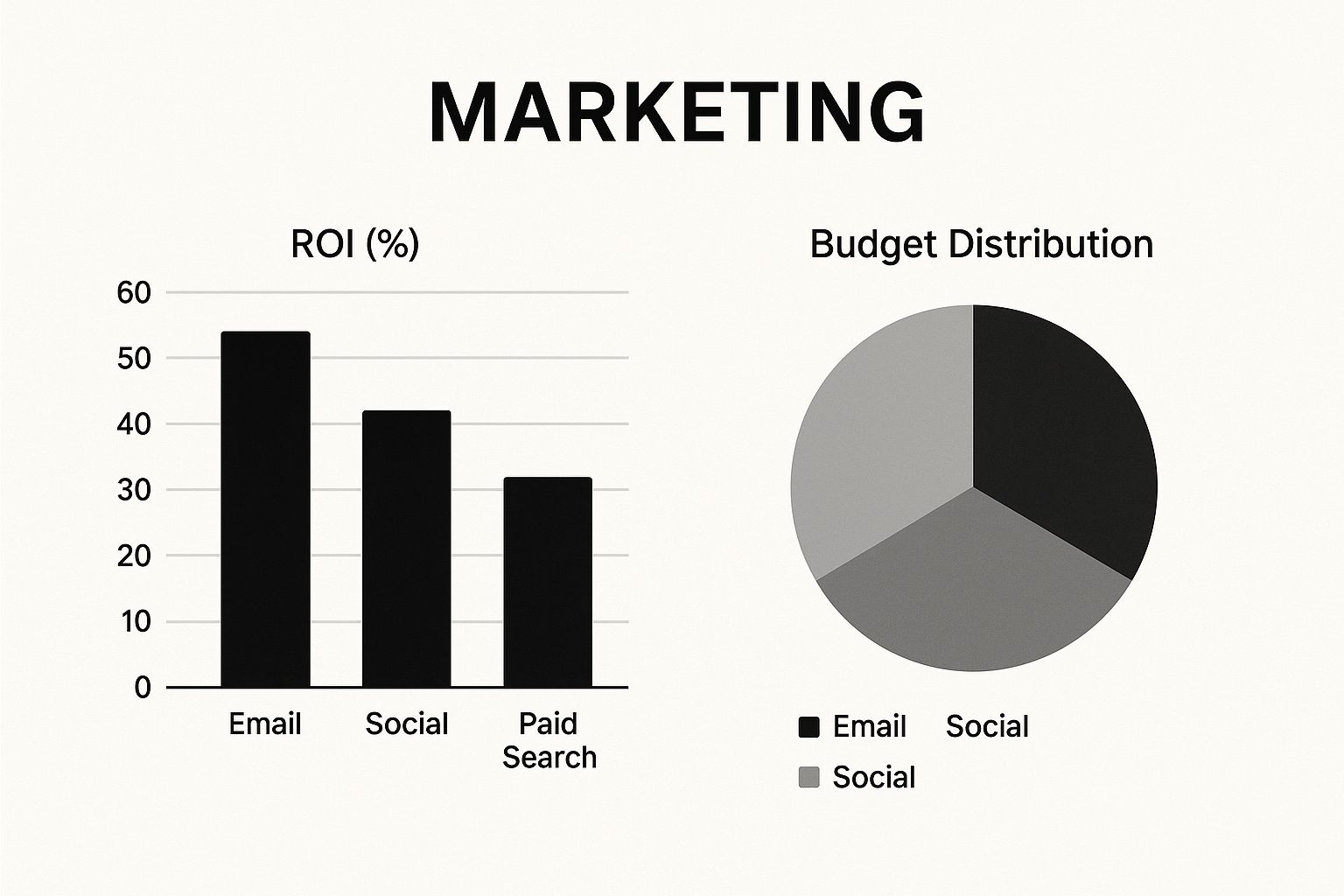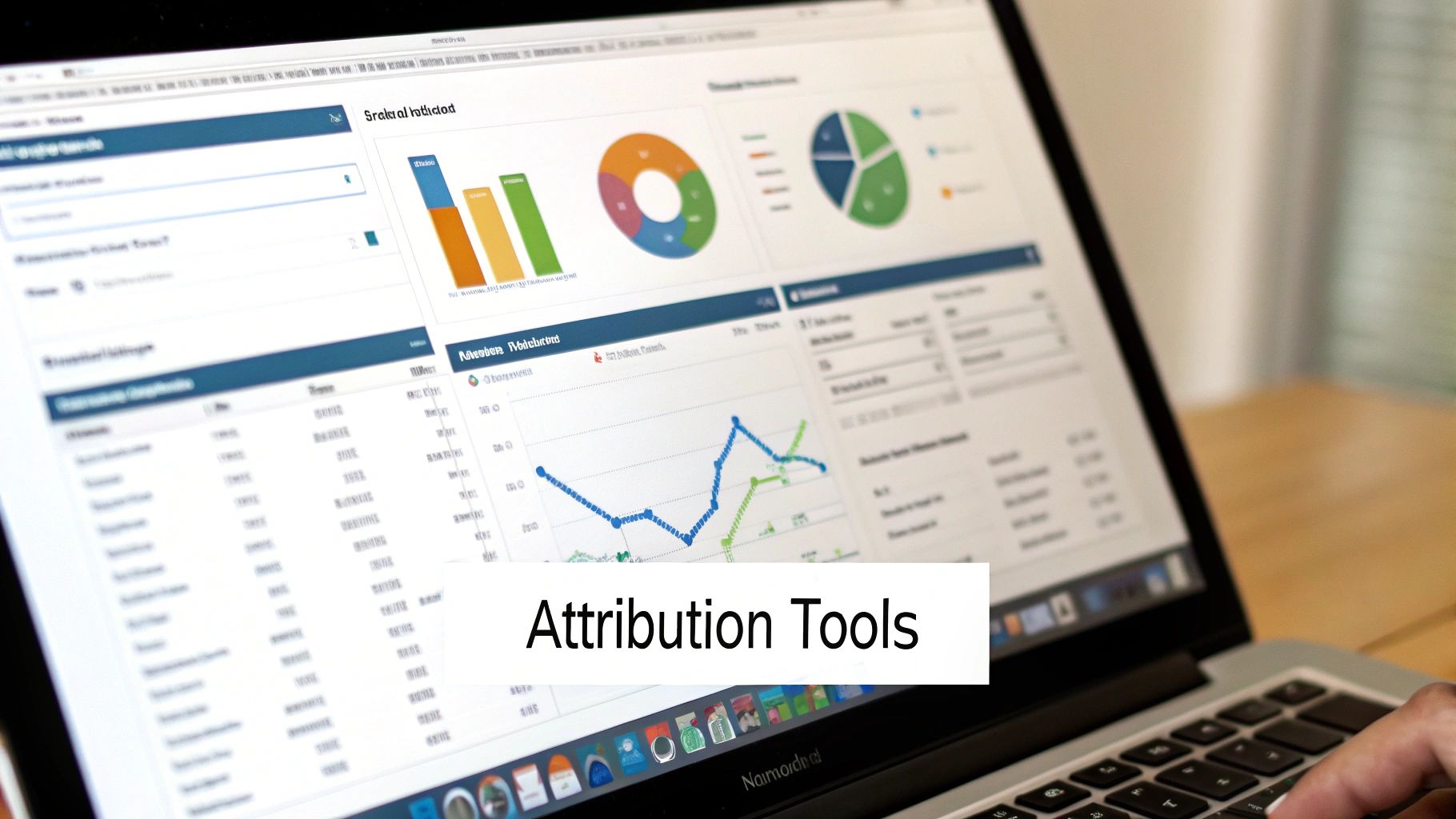Marketing Channel Attribution Mastery: Your Complete Guide
Marketing Channel Attribution Mastery: Your Complete Guide
Understanding Marketing Channel Attribution Fundamentals
Marketing channel attribution is essential for high-performing marketing teams. It helps understand the customer journey, revealing not just what happened, but why. By connecting the dots between marketing touchpoints and conversions, marketers can optimize campaigns and boost their return on investment (ROI). Attribution shows which marketing channels truly drive results, not just those that show up in reports.
Why Is Marketing Channel Attribution Important?
Basic tracking only shows that a customer clicked an ad or visited your website. It doesn't tell the whole story. For example, a customer might discover your product through social media, then click a paid search ad, and finally purchase after receiving an email. Basic tracking might credit the email, but attribution recognizes each touchpoint's contribution. This holistic view allows for optimized spending across all channels, leading to more efficient campaigns and a higher ROI. Businesses mastering attribution often see significantly better returns—sometimes 3x better—on their marketing spend.
The Evolution of Attribution
Digital marketing has changed how we approach attribution. In the early 2000s, the last-click attribution model, common in tools like Google Analytics, gave all credit to the final touchpoint before conversion. While effective for direct-response channels, it missed the influence of earlier interactions. As customer journeys became more complex, multi-touch attribution models emerged, distributing credit across multiple interactions. By 2019, multi-touch models were widely accepted as more accurate, accounting for interactions across channels, devices, and sessions. This provided a more complete understanding of the customer journey. Explore this topic further here.
Benefits of Effective Attribution
Implementing marketing channel attribution offers several benefits:
- Identify high-performing channels: See which channels drive the most conversions.
- Optimize budget allocation: Invest in channels with the highest ROI.
- Refine messaging and targeting: Tailor messaging based on customer interaction with each channel.
- Improve campaign performance: Make data-driven decisions to optimize campaigns.
By understanding marketing channel attribution fundamentals, you can go beyond basic tracking and unlock your marketing's true potential. This knowledge builds a foundation for a more effective marketing strategy, leading to increased conversions and improved ROI.
Essential Attribution Models Every Marketer Should Know
Understanding marketing channel attribution can be tricky, but knowing the basics is important for any marketer. Each model assigns credit for conversions differently across the customer journey. Picking the right model depends on your business goals and how complex your customer journey is.
First-Click Attribution
This model gives 100% of the credit to the first touchpoint. This helps you see which channels first introduce customers to your brand. For example, if a customer's first interaction is through a Pinterest Marketing campaign and they later convert through email, Pinterest gets all the credit. This model works best for businesses focused on brand awareness and top-of-funnel marketing.
Last-Click Attribution
This model, often the default in analytics platforms like Google Analytics, gives 100% of the credit to the last touchpoint before conversion. It's easy to understand but might undervalue earlier interactions. For example, if a customer reads blog posts and sees social media ads before buying through a paid search ad, only the search ad gets credit. While it's good for analyzing direct response campaigns, it misses the impact of other channels.
Linear Attribution
Linear attribution spreads the credit evenly across all touchpoints. This model acknowledges every interaction, giving a balanced view. For example, if a customer interacts with four touchpoints before converting, each gets 25% of the credit. This is fairer than single-touch models, but it may not accurately reflect the true influence of each channel.
U-Shaped and W-Shaped Attribution
These models focus on key touchpoints. The U-shaped model gives 40% credit to the first and last touchpoints, and 20% to everything in between. The W-shaped model, used for deal creation and revenue attribution, gives 30% each to the first, lead creation, and deal creation touchpoints, with the remaining 10% spread across other interactions. These models highlight both initial engagement and actions that drive conversions.
Time Decay Attribution
This model gives more credit to touchpoints closer to the conversion, acknowledging their growing influence. This is helpful for businesses with longer sales cycles. A touchpoint one day before conversion gets more credit than one a week before. This model helps you understand which activities speed up conversions.

This infographic compares ROI across Email, Social Media, and Paid Search, along with their budgets. Email marketing, with a smaller budget, shows a much higher ROI. You might be interested in: How to master marketing channel attribution. This highlights the need to evaluate and optimize channel budgets based on attribution data, perhaps shifting resources to better-performing channels.
To help you choose the right attribution model for your business, take a look at the comparison table below:
To help you choose the right attribution model for your business, take a look at the comparison table below:
Attribution Models Comparison Guide
A comprehensive comparison of different attribution models showing their strengths, weaknesses, and ideal use cases
| Attribution Model | Credit Distribution | Best Use Case | Pros | Cons |
|---|---|---|---|---|
| First-Click | 100% to the first touchpoint | Brand awareness campaigns | Simple to understand, identifies initial engagement channels | Ignores later touchpoints, doesn't show full customer journey |
| Last-Click | 100% to the last touchpoint | Direct response campaigns | Easy to implement, highlights conversion-driving channels | Undervalues earlier touchpoints, not suitable for complex journeys |
| Linear | Credit distributed evenly across all touchpoints | Businesses with simple customer journeys | Fairer view than single-touch models | Doesn't reflect varying influence of channels |
| U-Shaped | 40% to first and last touchpoints, 20% distributed evenly across middle interactions | Businesses focusing on both initial engagement and conversions | Emphasizes key touchpoints | May not be suitable for very long or complex journeys |
| W-Shaped | 30% to first, lead creation, and opportunity creation touchpoints, 10% spread across other interactions | Businesses focused on lead generation and opportunity creation | Highlights critical stages in the sales process | More complex to implement, requires detailed tracking |
| Time Decay | More credit to touchpoints closer to the conversion | Businesses with longer sales cycles | Recognizes increasing influence of later touchpoints | Can undervalue early touchpoints that build awareness |
Key takeaways from the table include the simplicity of First and Last-Click models, the balanced approach of Linear attribution, and the emphasis on specific touchpoints in U-Shaped and W-Shaped models. Time Decay's focus on later touchpoints is valuable for businesses with longer sales cycles. Choosing the right model is crucial for understanding the customer journey and optimizing marketing efforts.
From Media Mix Modeling To Data-Driven Attribution

Marketing channel attribution has evolved significantly. Early marketers faced challenges in understanding channel effectiveness and often relied on intuition for budget allocation. Media Mix Modeling (MMM), emerging in the 1950s and gaining traction in the 1980s, offered a solution. MMM uses aggregate data and statistical regression to estimate each marketing channel's contribution to sales. While it provided high-level insights for budget allocation, it lacked the granularity needed by digital marketers. Find more detailed statistics here.
The Rise of Data-Driven Attribution
By the mid-2010s, digital marketers began adopting more detailed models like data-driven attribution. This approach uses advanced data analysis and statistical modeling for more precise channel attribution. The shift marked a move from estimations to data-informed decisions. Data-driven attribution harnesses the power of big data and algorithms to provide a more granular view of each channel's contribution to conversions. Instead of simply knowing social media's role, you can now pinpoint specific platforms and even individual posts that influenced a purchase.
The Benefits of Granular Insights
This granular insight allows marketers to optimize campaigns in real-time. They can identify high-value conversion channels and adjust spending accordingly. Data-driven attribution also helps marketers understand the interplay between different channels. This allows them to see how touchpoints work together to influence the customer journey, rather than viewing each channel in isolation. As of 2023, data-driven attribution models have become increasingly popular for their ability to analyze large amounts of data and provide insights into channel contributions to conversions.
The Impact on Marketing Decisions
The shift toward data-driven marketing channel attribution has significantly changed marketing decision-making. Budget allocation is now a strategic, data-informed process. Attribution insights also inform content creation, messaging, and targeting, leading to more effective campaigns and better ROI. This transformation also impacts marketers' career growth, as data analysis skills become essential. Understanding and implementing data-driven attribution is now a necessity for marketers. You can learn more about implementing multi-touch attribution by visiting this link.
Implementing Multi-Touch Attribution Successfully
Successfully implementing multi-touch attribution requires a strategic approach. It acknowledges the complexities of real-world marketing and isn't a simple "set it and forget it" solution. Instead, think of it as an ongoing process of data collection, model selection, and optimization. This section outlines key steps successful marketers use to navigate these complexities.
Setting Up Data Collection and Integration
The foundation of any successful attribution model is accurate data. This means ensuring comprehensive tracking across all your marketing channels, both online and offline. This might involve integrating various tools, from your CRM (Salesforce) and analytics platforms (Google Analytics) to marketing automation software (HubSpot).
For example, connecting your CRM to your ad platforms allows you to track leads from initial ad clicks through to final conversion. Additionally, using a consistent tagging strategy with UTM parameters provides more granular tracking of specific campaigns and content. You might be interested in: How to master multi-touch marketing attribution.
Choosing the Right Attribution Model
There's no single "best" attribution model. The right choice depends on your business goals, the complexity of your customer journey, and data availability. A business focused on brand awareness might prioritize first-click attribution, while one focused on immediate conversions might choose last-click attribution.
More complex models, like the W-shaped model, are better suited for businesses with longer sales cycles and multiple touchpoints. Experimenting with different models will help determine which provides the most accurate insights for your specific needs.
Handling Cross-Device and Offline-to-Online Tracking
Today's customer journeys often involve multiple devices. Someone might see an ad on their phone, do research on their laptop, and finally purchase on their tablet. Accurately tracking these cross-device interactions is crucial for a complete picture of attribution.
Solutions like unified ID systems and statistical modeling help bridge this gap. Similarly, connecting offline activities (like in-store visits or phone calls) to online behavior adds complexity, but also provides invaluable insight.
Ongoing Optimization and Analysis
Implementing an attribution model is just the starting point. Continuous monitoring and optimization are essential. This involves regularly reviewing the performance of your chosen model, comparing it against business outcomes, and making adjustments as needed.
For example, if you notice a channel is consistently undervalued, you might need to refine your model or adjust your tracking methods. This iterative process ensures your attribution strategy stays aligned with your business goals and provides actionable insights for improvement.
Navigating Organizational and Political Challenges
Attribution implementation can sometimes face internal resistance. Different departments might have varying priorities or be used to traditional measurement methods. Clearly communicating the value of attribution and getting buy-in from key stakeholders is essential.
This often involves presenting data clearly and concisely, highlighting how attribution can improve overall marketing performance and drive business growth. By addressing these challenges proactively, you can pave the way for a successful and impactful attribution implementation.
Overcoming Attribution Challenges And Data Limitations

Marketing channel attribution is a powerful tool, but it's not a perfect one. Several factors can influence how accurate your attribution data is. Understanding these limitations and adapting your strategies is key to getting the most out of attribution. This means accepting that real-world data is often messy and developing frameworks to make smart decisions even with imperfect information.
The Impact of Privacy Regulations
Privacy regulations like GDPR and iOS updates have significantly changed how we collect and track data. These changes restrict the use of cookies and other tracking tools. This makes it more difficult to follow individual user journeys across websites and devices. As a result, attribution data may be incomplete, especially for privacy-conscious users. For instance, if someone opts out of cookie tracking, some of their interactions won't be captured, creating gaps in the data.
Addressing Cookie Limitations and Cross-Device Tracking
The decline of third-party cookies poses a significant challenge. These cookies were once the primary way to track users across different websites, giving marketers a broader view of online interactions. Exploring multi-channel strategies can be beneficial for reaching customers across different platforms. You can learn more about this in Multi-Channel Ads. With increasing restrictions on third-party cookies, alternative tracking methods like server-side tagging and differential privacy are becoming more important. These aim to balance user privacy with effective tracking.
Dealing With Incomplete Customer Journeys
It's rare to capture a customer's entire journey. People interact with brands across many channels, both online and offline, making it tough to connect every touchpoint. Data discrepancies between platforms can also create conflicting information, making it harder to get a clear picture of attribution. Marketers need to be comfortable with some level of uncertainty and create strategies for handling these gaps in attribution. Using probabilistic modeling and focusing on the most influential touchpoints, even without the full journey, can be effective. You can find more about this topic in our article, How to master marketing channel attribution challenges and their fixes.
Making Decisions With Imperfect Data
Even with imperfect data, marketers still need to make decisions. This requires learning to interpret incomplete information and draw useful conclusions. A deep understanding of your customer base, their behavior, and the limitations of your data is essential. It also means prioritizing actionable insights over perfect accuracy. By focusing on the data you do have and applying it strategically, you can make informed decisions that boost marketing performance, even with data limitations.
Optimizing Marketing Budgets With Attribution Insights
Marketing channel attribution isn't just about understanding where your customers come from. It's about using that knowledge to make informed budget decisions. Successful marketers use attribution data to optimize spending, making sure every dollar contributes to real business growth.
This means identifying which channels are working best, finding hidden opportunities, and making data-driven decisions for maximum impact.
Identifying High-Performing Channels and Reallocating Spend
Attribution models clearly show which channels contribute most to conversions. By analyzing this data, marketers can pinpoint the channels generating the highest ROI.
This allows for strategic budget reallocation, moving resources away from underperforming channels and towards those driving the best results. For instance, if email marketing consistently outperforms social media, it makes sense to increase the email budget and decrease social media spend.
Uncovering Hidden Opportunities and Optimizing Campaign Timing
Marketing channel attribution can also reveal undervalued channels that your competitors might be missing. This gives you a competitive edge, letting you capitalize on these untapped opportunities.
Attribution insights can also help optimize campaign timing. By understanding when and how customers interact with each channel, you can schedule campaigns for maximum impact, avoiding wasted budget on poorly timed initiatives.
Connecting Attribution Data to Budget Planning and Strategy
Integrating attribution data into your budget planning process is essential. This means using these insights to inform quarterly budgets, seasonal optimizations, and long-term channel development.
This data-driven approach ensures your budget aligns with your marketing objectives and maximizes ROI.
To better illustrate how you can use attribution data to make smarter budget choices, let's examine the following table. It provides a practical framework for translating insights into actionable budget allocations across various channels.
Budget Optimization Framework Using Attribution Data
A practical framework showing how to translate attribution insights into budget allocation decisions across different channels
| Channel | Attribution Score | Current Budget % | Recommended Budget % | Expected Impact |
|---|---|---|---|---|
| Organic Search | 8 | 20% | 25% | Increased website traffic and leads |
| Paid Search | 7 | 30% | 25% | Maintain conversion rate while reducing spend |
| Social Media | 5 | 25% | 15% | Focus on engagement and brand building |
| Email Marketing | 9 | 15% | 25% | Increased conversions and customer retention |
| Referral | 6 | 10% | 10% | Maintain steady referral traffic |
This table demonstrates how attribution scores can directly inform budget decisions. By increasing spending on high-performing channels like Organic Search and Email Marketing, and decreasing spending on less effective channels, you can optimize your budget for the greatest impact.
For even more detailed insights, consider using a tool like LeadPulse to refine your attribution strategy and discover where your leads and customers originate. This will help you pinpoint the channels driving the most valuable conversions.
Presenting Attribution Findings and Securing Buy-In
Presenting attribution data effectively is vital for securing buy-in from stakeholders. Communicate your findings clearly and concisely, focusing on the positive impact of these data-driven choices.
By showing how marketing channel attribution leads to improved ROI and measurable business growth, you can gain support for future data-driven marketing investments. Establishing frameworks for measuring the ROI of your attribution efforts also adds credibility and proves the value of this approach.
Measuring Success And Continuous Attribution Improvement

Establishing sustainable practices for monitoring and improving your marketing channel attribution is crucial for long-term success. This means looking beyond surface-level metrics and focusing on tangible business results. It also requires adapting your strategies as customer behavior and your business change over time. This section explores important metrics, testing methods, and strategies for continuous improvement.
Key Metrics for Evaluating Attribution Model Accuracy
While metrics like click-through rates and impressions can be helpful, they don't provide a complete picture of attribution effectiveness. Instead, concentrate on metrics directly tied to business outcomes.
- Return on Ad Spend (ROAS): This metric measures the revenue generated for every dollar spent on advertising. A higher ROAS generally indicates a more effective ad spend.
- Customer Lifetime Value (CLTV): This metric predicts the total revenue a customer will bring in throughout their relationship with your company. Attribution can help pinpoint which channels are attracting high-CLTV customers.
- Conversion Rates by Channel: This metric demonstrates how well each channel converts leads into paying customers. It’s valuable for comparing channel performance and finding areas for improvement.
These metrics offer a more comprehensive understanding of your marketing impact. This data-driven approach ensures your attribution model stays aligned with your overall business objectives.
Testing Model Performance Against Real Business Outcomes
Regularly testing your attribution model’s accuracy is vital. This involves comparing the model's predictions to your actual business results. For instance, if your model predicts a specific ROAS for a particular channel, track the actual ROAS and compare the two.
Any significant differences between predicted and actual results could indicate the need for adjustments. This might involve refining the model's parameters or even adopting a different model.
Strategies for Continuous Improvement
The customer journey is dynamic. Your marketing channel attribution strategy needs to keep up. This requires continuous improvement and adaptation. Regularly audit your attribution model, looking for ways to enhance its accuracy and effectiveness.
Also, consider incorporating customer feedback and market research into your analysis. This qualitative data offers valuable context and can uncover insights that data alone may miss.
Balancing Sophistication with Actionable Insights
While complex attribution models can be powerful, strive for a balance between sophistication and actionable insights. Overly complex models can be difficult to interpret and use, potentially leading to analysis paralysis. Focus on using your data to make practical, data-driven decisions that boost marketing performance. Prioritize clarity and actionability.
Frameworks for Regular Attribution Audits and Model Validation
A regular audit schedule is essential for ensuring your model stays aligned with your business goals and adapts to evolving customer behavior. Consider factors like your sales cycle length and marketing campaign frequency when determining how often to conduct audits.
During these audits, validate your model using methods like A/B testing and holdout groups. A/B testing compares the performance of different attribution models, while holdout groups let you test your model's predictions against a control group.
Recognizing When It's Time to Upgrade or Rethink Your Approach
Several factors can signal the need for a shift in your attribution strategy. If your model consistently underperforms in predicting business outcomes, it may be time for an upgrade. Significant business changes, like entering new markets or launching new products, also necessitate adjustments to your attribution model. By recognizing these signs and proactively adapting, you can maintain effective marketing attribution and drive sustainable growth. Are you ready to understand your customer journey better and optimize your marketing ROI? LeadPulse helps you uncover the true impact of your marketing efforts by tracking leads and customers across all channels. See how LeadPulse can enhance your marketing attribution strategy and unlock your business's full potential.